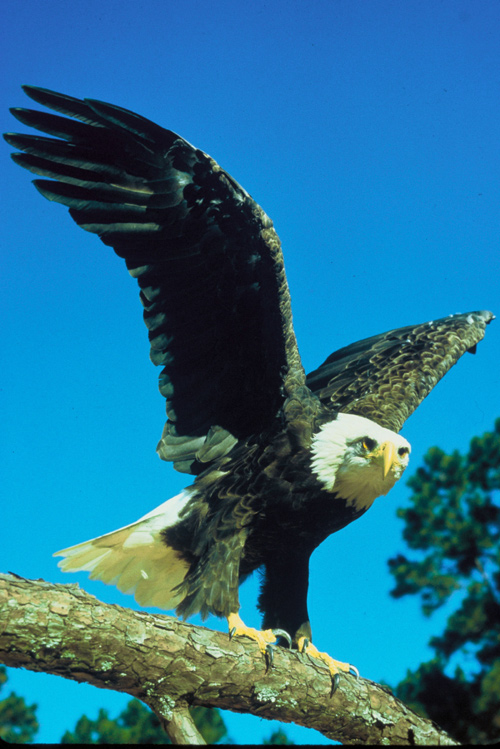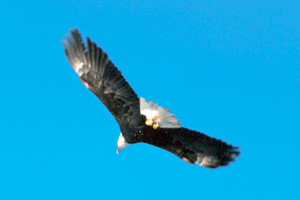Bald eagles are well-known as the national bird of the US. Their heads and tails are white and their body feathers are a dark brown. Their feet, eyes and bills are yellow. Juvenile bald eagles are gray-brown all over and don't develop adult plumage for 4 or 5 years. The adults can weigh between 8 and 14 pounds and their wingspans are generally 6 to 8 feet.
Bald eagles were common through the US in the 1700s. Their populations, as well as the populations of many raptors, suffered from habitat loss and pesticide exposure. In particular, the common use of DDT in the mid 20th century contaminated the food chain. The chemical caused the egg shells produced by many birds to be weakened to the point that the eggs just broke rather than surviving incubation. DDT was banned in 1972. The ban along with conservation measures have helped eagle populations to recover. They have gone from being a Federal Endangered Species in 1967, to a Federal Threatened Species in 1995, to being removed from the Federal lists completely in 2007. Bald eagles are easily disturbed by human activity and nesting and feeding areas are still often protected by law.
Today bald eagles are permanent residents all along the eastern US coastline, in the nothwestern corner of the US, along the western coast of Canada and along the southern coast of Alaska. They can spend winters all across the continental US, and move up through much of Canada and Alaska in the summer.
In Connecticut, bald eagles had disappeared as nesting residents by the 1950s. In 1992 a nesting pair returned to Connecticut and raised 2 chicks. These two birds were from a reintroduction program of the Massachusettes Division of Fish and Wildlife. Since then bald eagles have been making a comeback in Connecticut. In 2010, 18 pairs were known to have built nests in the state. The bald eagle is still listed as a Threatened Species in the state of Connecticut.
Bald eagles live along lakes, rivers, marshes and coastlines. They use tall trees and sometimes rocky cliffs for nesting and roosting. In winter they move southwards as necessary to find open water for fishing.
Bald eagles eat alot of fish. They will catch their own or steal fish from osprey or gulls. They will also feed on carrion or catch mammals and birds. They kill prey with their talons and tear it into edible-sized pieces using their beaks. An eagle can carry about 4 pounds in flight.
In Connecticut bald eagles mate in January. The same two eagles may breed together for years, although if one dies the other will seek another mate. They build large platforms of sticks lined with softer grasses for nests that are often used year after year. The nests are in a tree or on a rocky cliff 10 to 150 feet above the ground. 1 to 3 eggs are laid in February and March. Both parents care for the eggs and the chicks which hatch out after about 35 days. The baby eagles fledge in about 12 weeks and reach sexual maturity in 4 to 6 years. The lifespan of bald eagles is about 25 to 30 years in the wild.

